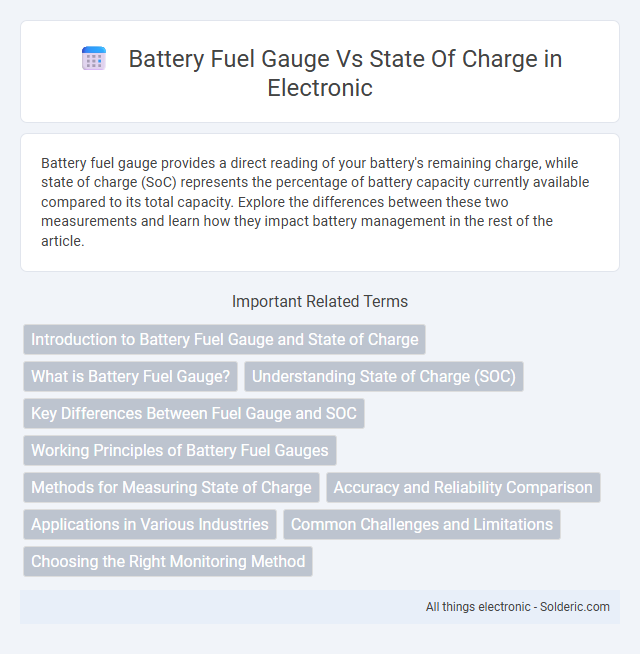Battery fuel gauge provides a direct reading of your battery's remaining charge, while state of charge (SoC) represents the percentage of battery capacity currently available compared to its total capacity. Explore the differences between these two measurements and learn how they impact battery management in the rest of the article.
Comparison Table
| Feature | Battery Fuel Gauge | State of Charge (SoC) |
|---|---|---|
| Definition | Device or system that estimates remaining battery capacity and runtime. | Percentage indicating the current charge level relative to full capacity. |
| Measurement Basis | Uses voltage, current, temperature, and coulomb counting methods. | Calculated from battery voltage, current, and capacity data. |
| Purpose | Provides real-time battery status to inform users or systems. | Indicates exact charge percentage for battery management and control. |
| Output | Remaining capacity, runtime, and sometimes health metrics. | Numerical value (%) showing battery charge level. |
| Application | Smartphones, electric vehicles, laptops, and battery management systems. | Battery monitoring, state estimation, and energy management. |
| Accuracy | Depends on sensor quality and algorithm sophistication. | Varies with estimation model and battery condition. |
Introduction to Battery Fuel Gauge and State of Charge
Battery fuel gauge technology provides real-time monitoring of a battery's remaining capacity by measuring voltage, current, and temperature to estimate how much energy is left. State of Charge (SoC) quantifies the current charge level as a percentage of the battery's maximum capacity, serving as a critical parameter for battery management systems. Accurate fuel gauge algorithms integrate SoC calculations to optimize battery usage, improve longevity, and prevent unexpected power loss.
What is Battery Fuel Gauge?
A battery fuel gauge is an electronic device or algorithm that accurately measures and reports the remaining charge in a battery, providing real-time data on battery capacity. It monitors parameters like voltage, current, temperature, and battery chemistry to estimate the State of Charge (SoC) with high precision. Fuel gauges are essential in applications such as smartphones, electric vehicles, and portable electronics to optimize battery usage and prevent unexpected power loss.
Understanding State of Charge (SOC)
State of Charge (SOC) represents the current energy level of a battery expressed as a percentage of its total capacity, providing critical insight into how much charge remains. Battery fuel gauges measure SOC by monitoring voltage, current, and temperature to deliver accurate and real-time data on your battery's health and usage. Understanding SOC helps in optimizing battery performance, extending battery lifespan, and preventing unexpected power loss.
Key Differences Between Fuel Gauge and SOC
Battery fuel gauge measures the remaining charge as a direct indicator of available battery capacity, while state of charge (SOC) estimates the percentage of total battery capacity currently stored. The fuel gauge provides an instantaneous reading often based on voltage or current, whereas SOC incorporates complex algorithms considering factors like temperature, battery age, and discharge rate for a more accurate representation. Understanding these key differences helps you better monitor and optimize battery performance and lifespan.
Working Principles of Battery Fuel Gauges
Battery fuel gauges estimate the state of charge (SoC) by measuring voltage, current, and temperature to provide accurate battery capacity readings. These devices use algorithms like coulomb counting and impedance tracking to monitor charge consumption and predict remaining battery life. Your device's performance and battery health rely on the precision of these gauge measurements to prevent unexpected power loss.
Methods for Measuring State of Charge
Battery fuel gauge systems estimate the state of charge (SoC) using coulomb counting, which tracks current flow in and out of the battery to provide precise charge measurement over time. Voltage-based methods infer SoC by correlating open-circuit voltage with charge levels, though accuracy is affected by temperature and battery aging. Your device may combine these techniques with impedance spectroscopy or machine learning algorithms to enhance SoC accuracy and reliability in real-time applications.
Accuracy and Reliability Comparison
Battery fuel gauges provide an accurate measurement of remaining energy by using algorithms that estimate State of Charge (SoC) based on voltage, current, and temperature data, enhancing precision in real-time monitoring. SoC measurement reflects the exact percentage of battery capacity available, but accuracy can be influenced by battery chemistry, aging, and operating conditions, making advanced fuel gauges more reliable over time. High-quality fuel gauge ICs integrate adaptive learning and compensation techniques, resulting in superior reliability and consistency compared to basic SoC estimation methods.
Applications in Various Industries
Battery fuel gauges provide real-time data on the available energy in a battery, while state of charge (SoC) estimates the remaining capacity as a percentage of total battery life. Industries such as automotive, aerospace, and consumer electronics rely on accurate fuel gauging systems to optimize battery management, enhance safety, and extend device runtime. Your ability to monitor SoC precisely ensures efficient energy use and maintenance scheduling across applications like electric vehicles, renewable energy storage, and portable medical devices.
Common Challenges and Limitations
Battery fuel gauges often struggle with accurately estimating the state of charge (SoC) due to variations in battery chemistry, temperature fluctuations, and aging effects, leading to inconsistent readings. Measurement errors can arise from voltage hysteresis and dynamic load conditions, which complicate SoC calculation algorithms. Limitations in sensor precision and the need for frequent recalibration further hinder reliable SoC estimation in real-world applications.
Choosing the Right Monitoring Method
Choosing the right monitoring method between battery fuel gauge and state of charge (SoC) depends on accuracy and application needs. Fuel gauges offer precise measurements by integrating current over time, suitable for devices requiring detailed tracking, while SoC estimates provide a quicker, less complex approximation ideal for general use. Understanding your battery's specific requirements will help you select the optimal method for reliable power management and longer battery life.
Battery fuel gauge vs state of charge Infographic

 solderic.com
solderic.com